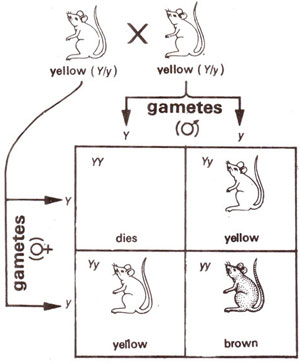There are genes which control certain phenotypic traits, and at the same time also influence the viability of the individuals. For jnstance, white eyed and vestigial winged flies have lower viabilities than the wild types. There are still other genes which have no effect on the phenotype but influence the viability. This influence on viability may be of such an order that the individual may fail to survive. Such genes which cause the death of the individual carrying it are known as lethal genes.
If the lethal effect is dominant over its normal allele, all individuals carrying it will die and the gene cannot be transmitted to next generation. Such dominant lethal genes will, therefore, be lost in the same generation. On the other hand, recessive lethals are carried in heterozygous condition, and will express themselves only in the homozygous condition. In
Drosophila genes like curly wings
(Cy), plum eyes
(Pm) and stubble bristles
(Sb) influence the viability of the flies when present in homozygous condition.
For instance, an individual
Cycy (heterozygous) will have curly wings and will survive. However, homozygous dominant i.e.,
CyCy will not survive. These genes, therefore, have dual effect. They are dominant with respect to the phenotype (e.g. curly wings, plum eyes and stubble bristles) but are recessive with respect to the lethal effect (consult
Mutations : 1. Morphological Level (Including Lethal Mutations)). In 1905, a French geneticist, L. Cuenot reported on the inheritance of mouse body colour, which did not fit the expected Mendelian segregation pattern. It was shown that yellow body colour was dominant over normal brown colour and was controlled by a single gene which may be designated as
Y.
It was fowid that yellow mice could never be obtained in homozygous condition. When yellow mice were crossed among themselves, segregation for yellow and brown body colour was obtained in 2 : 1 ratio. The brown individuals were pure and were, therefore, homozygous and yellow individuals as usual were heterozygous. These results could be explained on the assumption that the dominant allele for yellow body colour is lethal in homozygous condition. In other words, we may say that, while the gene
Y is dominant for its effect on the body colour, it is recessive for lethality. Consequently whenever a homozygous individual for
Y is produced, the lethal character will express itself and the individual will die. Homozygous yellow will thus never be produced. If
Y is the dominant allele for yellow body colour and
y is its recessive allele, the results can be expressed as in Figure 3.1.

Fig. 3.1. Segregation for yellow body colour when yellow mice are intercrossed.
Soon after Cuenot's discovery in mouse,
E. Baur in 1907 reported a lethal gene in snapdragon,
Antirrhinum majus. He found that when yellow leaved dominant genotype called
aurea was crossed with its own type
(aurea x aurea), normal
green plants and
aurea heterozygotes were obtained. Aurea homozygotes were though obtained, but lacked the ability to make chlorophyll so that they died before germination or as seedlings.
A large number of such lethal factors are known in a variety of individuals. For instance in chickens, the character 'creeper' is dominant for its effect on phenotype but is recessive for lethality.
In human beings also there are diseases like
infantile amaurotic idiocy and
thallassemia major which are associated with lethal factors. Similarly in large number of plant materials, recessive Iethals have been reported. These lethals in plants mostly exhibit themselves through loss of capacity to produce chlorophyll.
Penetrance of lethals
The genes causing lethality may differ in the level of their penetrance and expressivity. This results in a broad range of effects ranging from a condition where no survival is observed among affected genotypes, to those where almost complete viability is observed. Many of these genes which do not cause definite lethality are called
semilethals or
subvitals. It is difficult to draw a line between categories of lethals, but usually only those genes are regarded as lethal genes, which cause the death of the organism at an early stage.
Balanced lethal systems
Itwas shown fairly early, that lethal genes can be used to develop a
balanced lethal system, where both homozygotes, dominant and recessive will c e so that the surviving phenotype will always be the same and will consist of heterozygotes only. Such balanced lethal systems are known in
Drosophila, mice and
Oenothera.





